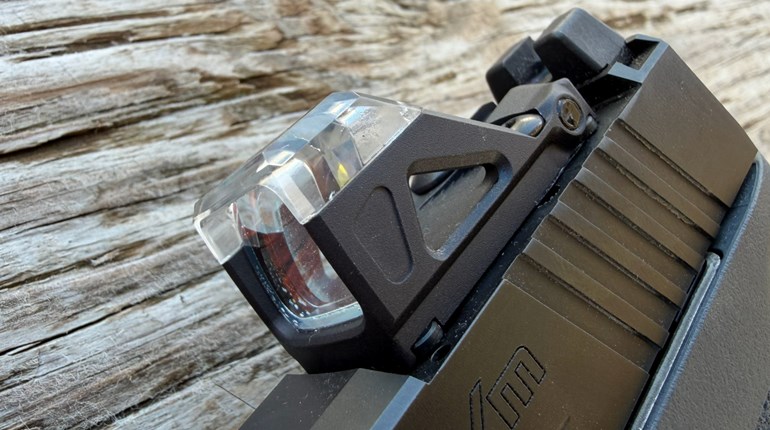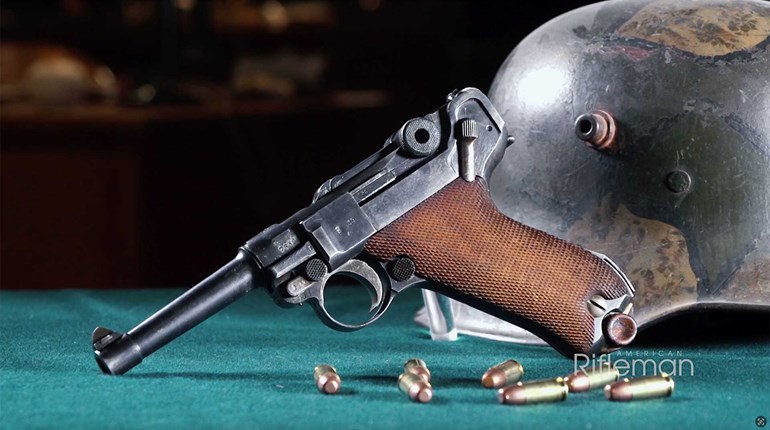
The popularity of using optics on handguns, all types of handguns, has exploded recently and for good reason. Handgun optics have gotten smaller, more versatile and more reliable. The result is there’s now a handgun optic for every reason and every season. Don’t believe us? Read on and find out why.
Any type of optical sight you can think of is available for handguns. This means scopes, red-dot sights, micro red-dot sights and enclosed emitter red-dot sights. But not all options are equal for all applications.
Telescopic Sights
Other than the sight on Han Solo’s blaster, scopes, aka telescopic sights, are the OG of handgun optics. It’s a bit fuzzy who was first, but Leupold and Burris both introduced their first handgun scope somewhere in the 1978/1979 time frame. Handgun scopes are just like riflescopes: they have the same parts, are available in fixed and variable magnification models and function the same. The critical difference is their eye relief. Eye relief is significantly extended on handgun scopes so the shooter can get a full sight picture at arm’s length. Handgun scopes are based on 1-inch tubes and are usually short to facilitate mounting on the limited space available on a handgun. The most notable handgun scope manufacturers are Burris and Leupold, and both have great options for big-bore revolvers, single-shots, etc.
Pro: Magnification, which is going to help with precise shot placement. The flat blade front sight on a big-bore revolver can cover up, or subtend for you scope junkies, almost a foot at 100 yards. That’s not exactly surgical aiming.
Con: There is a reason they’re not referred to as “reflex sights.” Target acquisition isn’t as quick as it is with a red-dot or even a scope mounted on a rifle.
Best Application: Hunting handguns, in particular large ones you’re going to shoot beyond 50 yards, such as big-bore revolvers, single-shot and bolt-action handguns or smaller handguns for shooting smaller targets such as small game.
![]()
Red-Dot Sights
Red-dot sights are like scopes, but different. They do not have a reticle, do not magnify, don’t really have parallax and have fewer parts than scopes. They have a diode that emits a red or green dot that is reflected onto a lens in your field of view. This dot is your aiming point. Put the dot on the target and fire. The aiming dots are available in various sizes, measured in MOA. So, for instance, if a red-dot has a 4-MOA dot, the dot will appear to cover 4 inches at 100 yards. Models with a tubular design like the Leupold RDS will require scope rings to mount on your handgun, while some like the Aimpoint Micro H-2 have an integral mount built into the body of the optic. If you’re going to go with a red-dot, just make sure you’ve got your mounting solution figured out.
Pros: They are great for quick target acquisition and are lighter than scopes.
Con: No magnification, so they are better suited to short- or mid-range applications.
Best Application: Hunting handguns used for short- to mid-range applications where quick target acquisition is required.

Micro Red-Dots
Micro red-dots have made handgun optics mainstream because they are so small, so light and so durable they can literally be mounted on semi-auto pistol slides. You can’t do that with tubular red-dots or scopes. Micro red-dots also have a diode that projects a dot onto a lens as an aiming point, but the diode is exposed to the elements, and they only have one lens. This is what makes them so small and so light. It is also what makes them not necessarily perfect for all applications, because if anything like water, snow, mud or debris gets between the diode and the lens, no dot, which means no aiming point. That said, micro red-dots are becoming more common on EDC (everyday carry) guns and could be a fine choice for a backcountry carry gun or even a hunting handgun in the right circumstance. Mounting these is a bit of a hodgepodge, as manufacturers have different “footprints” for mounting onto a base, although most have a Picatinny mounting base available as well. For direct mounting, the Trijicon RMR micro red-dot footprint is becoming a standard, and some firearm manufacturers are machining the “base” for the micro red-dot into the slide of their pistols so you can mount it directly to the slide rather than having to use an adapter plate or Picatinny rail and Picatinny mount.
Pros: Their small size makes them easy to mount on pistols or revolvers, providing a great aiming point and rapid target acquisition.
Con: The exposed diode can become blocked in foul weather or with mud or debris.
Best Application: Backcountry EDC.

Enclosed Microdot
While these aren’t as sleek-looking at the micro red-dots, they combine the advantages of tubular red-dots with micro red-dots and shed the disadvantages. These are essentially micro red-dots, but the emitter or diode is enclosed in a housing with an additional lens. This protects the emitter from water, mud or debris so there’s no worry about losing your aiming point. Mounting is more complex because you can’t put screws through the top of the sight into a base like you can on a micro red-dot. Different dot sizes are available to best suit your application. Additionally, the controls are easier to manipulate because they’re more accessible.
Pros: Protected aiming point, yet still small enough to mount on just about any handgun.
Con: Mounting can be more complex. No magnification.
Best Application: Handguns for short- to mid-range hunting.
Summary
Handgun optics are no longer a novelty relegated to big-bore revolvers or break-open single-shot hand cannons. The performance and versatility of the various options make them perfect for any hunting or outdoor application. They can easily extend your effective range, and in the case of the red-dots, even speed target acquisition. Give them a look for your next hunting handgun application.



































